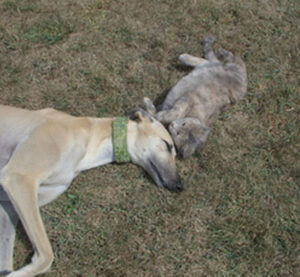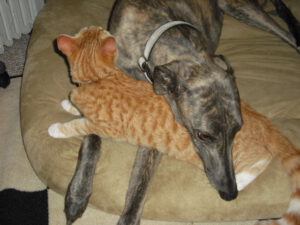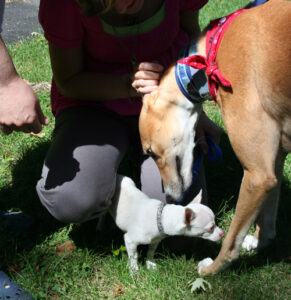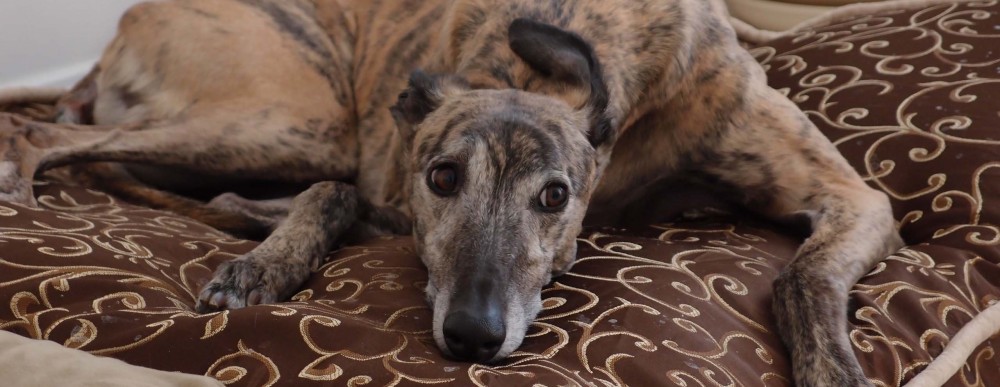Greyhounds and Cats
Of all of the questions we get about greyhounds, one of the most frequently-asked has to do with greyhounds and cats. We often get asked, “How do they get along with cats?”, or, we hear comments like, “I can’t have a greyhound because I have a cat.”
There are a lot of misperceptions about greyhounds and we think it’s because the image most people have about them is chasing that lure around the track. People automatically assume that, because of their past and training, no greyhound can live with cats.
Greyhounds are actually not that much different than any other breed of dog. Some greyhounds can live with cats and some are not. We at the Ranch take great care to test all of our greyhounds to make sure that they can live with cats. However, we cannot guarantee that there will never be a problem. It is important that potential adopters learn about the breed and become educated about how to properly introduce their greyhound to their cats. We require that all adopters with cats sign an adoption contract addendum agreeing to adhere to our advice and to properly introduce their greyhound to their cats.

Although racing greyhounds have been trained to chase a lure, they can be taught to live with cats. However, a responsible and knowledgeable person must be willing to teach them. The belief that greyhounds trained on a lure cannot learn to live with cats has been disproven time and again. It is possible that some greyhounds are more likely to present a challenge initially. However, common sense and patience go a long way in helping them overcome any interest in cats.
Note: We at the Ranch work tirelessly to find forever homes for greyhounds when they come off the tracks. We work hard to make sure that people with cats find a greyhound that will fit into their home. However, we feel that we need to focus on the greyhounds and finding them homes. There are many wonderful non-cat-tolerant greyhounds waiting for a group to take them or waiting for their forever homes. Some never get that chance and it’s only because they are not cat tolerant. All greyhounds deserve a home and should not be penalized or carry the burden for not being cat tolerant. If you do not have cats, we urge you to adopt a non-cat tolertant dog. We reserve the right to refuse to place a cat tolerant dog in a home without cats.
Greyhounds versus Cats, Cats versus Greyhounds

Greyhound and cat relationships can be described as a two way street. Some greyhounds do not like cats; some like being around cats; some are afraid of cats; and, some view cats as dinner. While cat testing is somewhat unscientific and conducted differently by people at kennels and in groups, one can usually get some sense of how a greyhound will behave around a cat. We foster all of our greyhounds and most are fostered with cats so we have a good sense of how a dog will behave around a cat.
However, no one can predict how any cat will take to suddenly having a greyhound walk into its house! Some cats are curious, some are quite put out and some are downright frightened! Some greyhounds like one cat, but may act differently around another. Some cats can tolerate one greyhound while they may hate another. Therefore, you must keep an open mind when it comes to expectations.
When we say that a greyhound is cat tolerant, we cannot and will not make promises that the same greyhound will get along famously with your cat(s). A lot depends on personalities.
Correct Introductions

One of the biggest mistakes an adopter can make is to assume that a greyhound and cat will automatically get along because the greyhound has been determined to be cat tolerant and/or has lived in a foster home with cats. Introductions should be made carefully. It’s important to keep a greyhound on a leash (and muzzled) indoors during the introduction period, even if this has to last for several days or weeks until you are certain that all will get along. It’s important to ensure the safety of the all feline members of your family. As you walk through the house with the leashed greyhound, it’s a good idea to encourage any positive interaction with the cat(s), even if it is just a glance in their direction. Watch to evaluate how the greyhound reacts to their presence. Any act of aggression such as lunging, barking, growling, etc. by the greyhound should be discouraged with a firm “NO” and firm (not hard) tugging on the leash.
If a greyhound doesn’t seem to be interested in the cat or if it turns its head away, that is a good sign and the greyhound should be praised. Continue to praise each time your greyhound walks past the cat, looks the other way, shows no interest, etc. There is never enough praise when your greyhound is behaving well around your cat.
Allow your cat to approach your greyhound but keep a tight hold on the leash in case there is a sudden move. If your cat bolts every time it sees your hound, you may have to do some extra work. A bolting cat can initiate the chase instinct in the greyhound. If your cat continually bolts, it may be a good idea to have another person keep the cat from running. Do not allow your greyhound to think of your cat as the lure at the track!

If your cat still has its claws and is not afraid to stand up to the greyhound, this may hasten the introduction process. A cat that hisses, spits, growls, stands its ground, etc. will definitely discourage a greyhound from getting too close. Sometimes one swipe across the nose will be all that it takes for a greyhound to learn to respect the cat!
(Note: Kittens are especially vulnerable to a greyhound and we usually will advise adopters not to adopt until the cat is full grown. Kittens are too playful and make too many sudden moves (in addition to being very small). A kitten could be hurt or killed easily by a large greyhound in pursuit.)
Once the leash comes off and the muzzle has been put away, never trust your greyhound alone with your cat(s) during the initial period of introduction. Make sure that someone is always present in case something gets started. If you leave your greyhounds and cats alone while you are away, always make sure that they are separated. Give your cats an “escape” route through a raised baby gate or cat door somewhere in your house.
Bad Introductions
Introducing cats and greyhounds by having them meet each other through baby gates, fences, windows and/or sliding glass doors is not a good idea. This can cause a greyhound to get agitated and make the cat run. It allows the greyhound to get out of control quickly. Greyhounds are trained by waving a fuzzy lure around it but not allowing it to catch it. This “teasing” encourages the greyhound to become more animated and it can produce an intensification in the desire to pursue the object that continually escapes.
One of the worst ways for a greyhound and cat to be introduced to one another is to allow nature to take its course. Do not, under any circumstances, drop a greyhound and cat together in a room and think that they will work things out. This is one way to ensure a disaster!
Introducing Multiple Pets

Introductions should be done with one animal at a time. You need to focus on how each pet in your house reacts to your new greyhound. Do not overwhelm your greyhound with too many animals at one time. This type of introduction may take extra time, but it is necessary if you want harmony to exist in your home. Each animal should be given enough time to become familiarized with the greyhound and the greyhound should be given time to get used to each animal’s scent, look and behavior. It’s important to look for signals that might indicate problems. Once all of the individual introductions have been made and everything seems to be safe, then it will be time to allow everyone to get together in a group with very careful monitoring. In multiple pet homes, it’s important to always be vigilant and to not become complacent. Chance are that your pack will eventually all get along but in the beginning it’s better to be safe than sorry.
Indoor Cats versus Outdoor Cats

Even if your greyhound is totally safe around your cats inside your home, when outdoors, all bets are off. A greyhound spotting a cat outside may give way to chase especially if the cat runs. An outdoor cat can provoke a greyhound’s prey instinct. If you have feral cats in your neighborhood or if your neighbors have cats that come in to your yard, there is no guarantee that your cat friendly greyhound won’t chase and destroy. Never assume that your greyhound has learned to accept all cats because he/she sleeps in the same house with your cat. Never allow your indoor cat to go outside with your greyhound unless you are prepared to lose your cat.
People and Cat Problems
One of the most common problems that can create an obstacle to a harmonious introduction between a cat and a greyhound is the tension and nervousness of the person doing the introduction. Greyhounds (and even cats) are very sensitive to what humans are feeling. Animals will respond negatively to this tension. A calm and patient demeanor will help in the beginning. A positive attitude will also help. Also, don’t make the mistake of thinking that one animal should be more important than another because one was there first. Animals do not think like humans. Do not try to set up a pecking order of who is most important as it will surely some day lead to problems.
Final Thoughts

Nothing makes for a happy and harmonious household more than to know that all of the animals in the house get along and live well together. By getting educated about the greyhound’s past, understanding the breed and taking the time to introduce and monitor all animals in the house, you can be sure that your greyhound will be right at home in record time!


